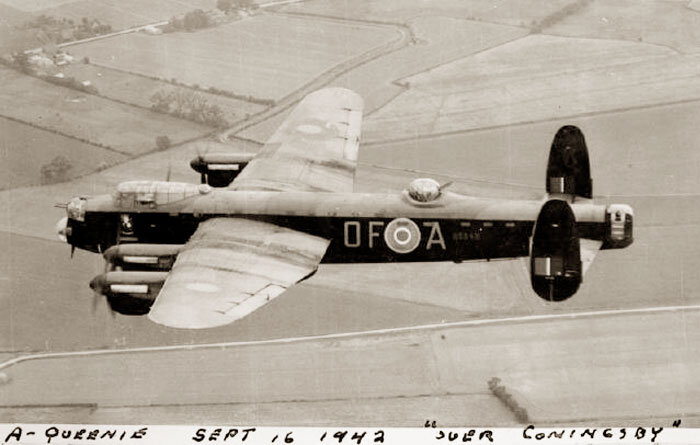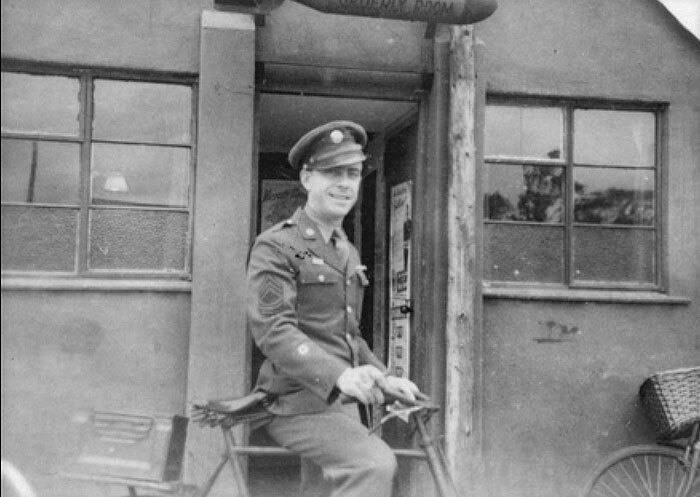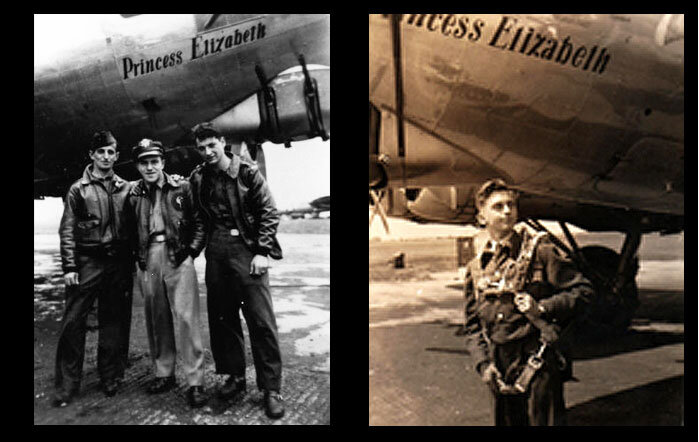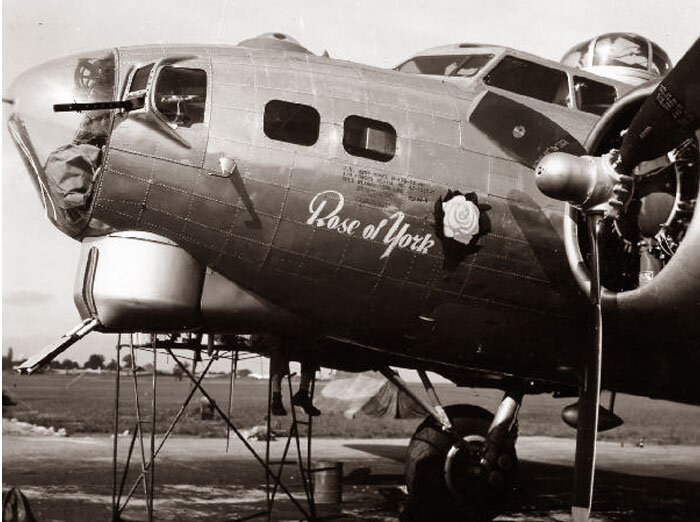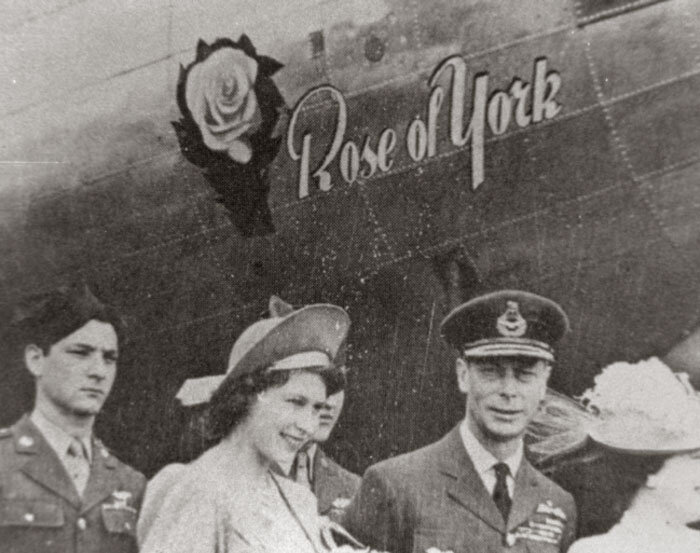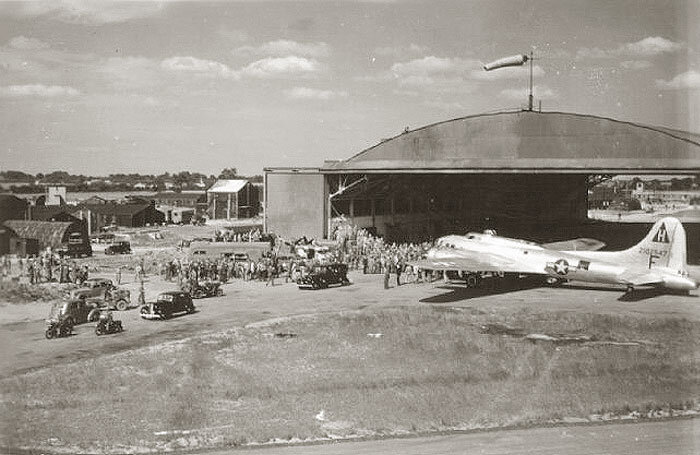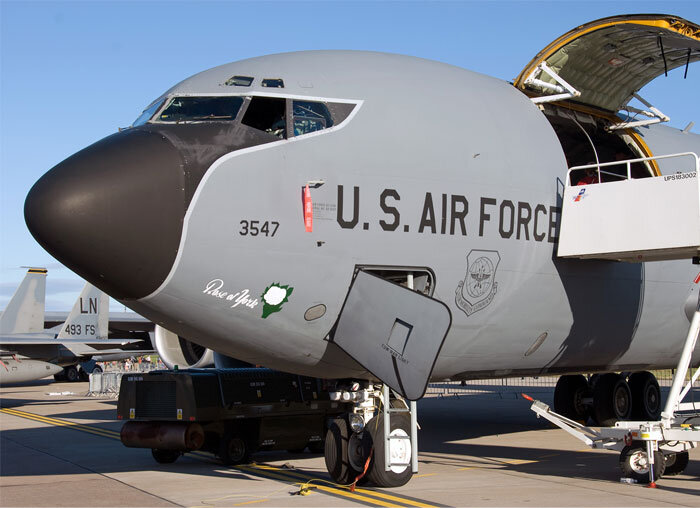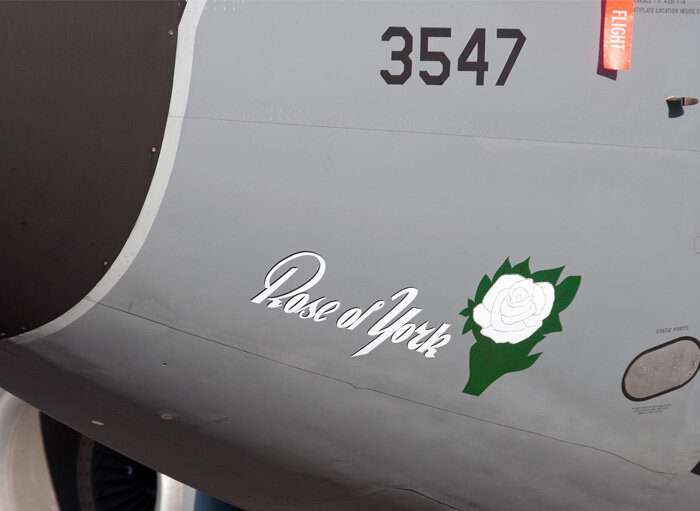ROSE OF YORK — A Fortress fit for a Princess
On 26 March 1942, His Majesty King George VI and his wife, Queen Elizabeth [now known as the Queen Mother] paid a formal visit to the early production line of Avro Lancaster Mk. I bomber aircraft being built at Yeadon, England. In their honour, a single Lancaster with serial number R5489* was given the name of George while another, serial number R5548, was named Elizabeth**. Unfortunately, both Lancasters had a typical short life with the Royal Air Force's Bomber Command as George, flying with No. 44 Squadron RAF, crashed on approach to RAF Waddington on 16 August 1942. Just four months later, on 28 December, the Lancaster known as Elizabeth, then with 97 Squadron RAF, exploded on the ground at RAF Woodhall when a photoflash flare accidentally went off. The first similar Royal visit to a United States Army Air Force base came on 13 November 1942, when the King and Queen toured RAF Thurleigh, home of the 8th Air Force's 306th Bomb Group. A second Royal visit to an American base was conducted by the couple on 25 May 1943, this time a fighter unit of the 8th A.F. – the 78th Fighter Group based at RAF Duxford.
RAF Thurleigh, the long-time home of the USAAF's 306th Bomb Group, was situated 5 miles north of Bedford in Bedfordshire. The 306th Bomb Group of the 8th Air Force was activated on 1 March 1942, at Salt Lake City, Utah. Having trained up on the Boeing B-17 Flying Fortress, the air echelon departed for England on 1 September 1942. They flew their first combat mission on 9 October 1942 and the last on 19 April 1945, for a total of 341. RAF Thurleigh airfield was the first base in England to be handed over completely to the USAAF, giving them full sovereignty and control of the field. The 306th stayed longer than any other Eighth Air Force combat unit at any single base and longer in England than any other Eighth Air Force combat unit.
The 306th had many bombers with creative nose art that became part of Group history, but the one named Rose of York surpassed them all. On 5 May 1944, the 367th Bomb Squadron of the 306th Bomb Group received a new Boeing Seattle-built B-17G Flying Fortress, with serial number 42-102547. It was assigned to the tender care of Master Sergeant Edward S. Gregory, from Salt Lake City, the birth city of the bomb group.
In mid-May of 1944, the B-17G received her first nose art name – Princess Elizabeth – painted in red block letters by Ed Gregory and Assistant Crew Chief Mark Madsen. The nose art had been requested by the first combat crew which was comprised of Captain Perry E. Raster (Pilot), Lt. Talmadge E. McDonough, Captain Stephen Tanella, Lt. William E. Pleasant, Lt. Marion J. Northway, Sgt. Eugene E. Kelly, Sgt. George G. Roberts, Sgt. Herman Shore, Sgt. William E. Landrum, Sgt. Donald F. Urban, and Sgt. Watson R. Vaughn.
Both Lancaster R5489 George and Lancaster R5548 Elizabeth were destroyed in England (see fates at end of story) during operations, but because of this, the Royal Family and RAF had fear of the propaganda that might be made if a similarly named aircraft was shot down over German-held territory or worse, captured. Photo via 97 Squadron Association Website
M/Sgt. Ed Gregory in front of an orderly room at Thurleigh, England, summer of 1943. The 306th Bomb Group was stationed in England, at the same base, longer than any other group in the 8th Air Force. Ed, a crew chief with the 306th Bomb Group, was assigned responsibility for the care and maintenance of B-17G (42-102547) a.k.a. Princess Elizabeth, The Princess, and finally Rose of York. Photo from Ed Gregory via Clarence Simonsen
When bombardier Stephen Tanella finished his tour early, he was replaced by Marion Northway. For some reason, unknown to Northway, the name Elizabeth was ordered removed by Eighth A.F. Command. Northway flew four missions with the nose art name The Princess: 21 June 1944 to Berlin, Germany, 22 June to Ghent, Belgium, 25 June to Joigny, France, and 28 June to Laon, France.
The reason for the name removal started in early June 1944, when a rumour began that the Royal Family and 18-year-old Princess Elizabeth were coming to visit the American base at Thurleigh. Suddenly the idea came to M/Sgt. Gregory to request that the real Princess Elizabeth christen her own B-17 which carried her name. At first, the idea moved slowly up the military hierarchy until it reached King George VI, who approved the idea but wanted the nose art name changed to be less explicitly the name of the Princess.
Two photographs of Boeing B-17G (serial number 42-102547) painted as Princess Elizabeth. The big Boeing completed 13 bombing missions over Nazi occupied Europe before her christening as Rose of York. Photo via 306th Bomb Group website
Related Stories
Click on image
The name change was due to the possibility that the B-17 might be shot down and that the German propaganda machine would benefit as they had when the B-17 bomber named Murder Incorporated was shot down on 26 November 1943. In the 1930s and 1940s, journalists used the term “Murder Incorporated” to refer to a collection of contract killers who worked for organized crime in the United States. Members of Murder Incorporated committed untold numbers of murders under orders from people in the mob; these murders were designed to protect the interests and secrecy of organized crime. When the B-17 bearing this name was shot down, the Nazi propaganda machine went to work, even stating that the crew were all convicted gangsters and murderers sent over to kill German women and children. This is why the 8th A.F. Command was so sensitive about bomber nicknames and ordered the name change. M/Sgt. Gregory removed the name Elizabeth and painted The Princess, but this was also rejected by the King.
The Nazi propaganda machine made hay from the shooting down of B-17 Murder Inc., claiming that they were convicted gangsters and killers sent to murder innocent German citizens. Photo from Berlin newspaper of the day via Ken Williams of Murder Inc. crew
To avoid further problems, His Majesty the King picked the new nose art name – Rose of York. Before his accession to the throne in December 1936 (due to the abdication of his brother King Edward VIII), King George VI was the Duke of York and his wife [the Queen Mother] was the Duchess of York, thus his daughter, became “his” – Rose of York.
In late June, the B-17G was scrubbed clean by M/Sgt. Gregory and his ground crew. The nose art name and bomb silhouette mission marks were removed, which had recorded 13 missions as Princess Elizabeth and The Princess. The new nose art names, with a large white rose, were painted on each side of the aircraft nose by an enlisted man from the 367th Squadron whose name is still unknown.
This photo of Rose of York shows her with absolutely pristine nose art and, on the other side, a small scaffold with someone clearly sitting on a platform, leading the editor to postulate that this is a photo of the B-17 actually undergoing painting of the nose art on her starboard side. This is also confirmed when another look reveals the flat board-like device attached to the chin turret's twin machine gun barrels which was used as a striker plate for the bottle of English cider used to christen the Fortress. This shows us that Rose of York is being prepped for the ceremony. Photo: USAF
The big day arrived on 6 July 1944, when Lt. Gen. James H. Doolittle, King George VI, Queen Elizabeth and Princess Elizabeth arrived in a formal motorcade of big black Daimler cars. M/Sgt. Ed Gregory presented Princess Elizabeth with twenty-four white roses to begin the ceremony. The Princess then swung a bottle of English cider against a striking plate attached to the gun barrels of the chin turret and the Rose of York was officially named in honour of Princess Elizabeth. During the ceremony, the B-17G's crew was standing in a row, five on each side of the bomber nose. Princess Elizabeth was then introduced to each of the crew members. The event ended when Capt. Perry Raster (Pilot), Lt. Talmadge McDonough (Co-pilot), Capt. William Pleasant (Navigator), T/Sgt. George Roberts and M/Sgt. Ed Gregory climbed aboard Rose of York and departed from the base. The Rose of York was flown to nearby RAF Molesworth, home of the 303rd Bomb Group, where the bomber was parked and the crew went for lunch. While the crew were having lunch, many photos were taken which, over time, led some historians to write the christening took place at Molesworth. [The 303rd Hell's Angels website indicated that in fact the Princess' motorcade later made an appearance at Molesworth. – Ed]
A special Royal luncheon was held at the Senior Officers’ Mess at Thurleigh, where Princess Elizabeth was presented with a thermos of American ice cream made from the base ice cream machine. The Royal party moved on to RAF Kimbolton, home of the 379th Bomb Group, where Princess Elizabeth was introduced to a second B-17G crew – nose art “Four of a Kind”.
The 18-year-old and very composed Princess Elizabeth chats with famed U.S. Army Air Force General James Doolittle at the beginning of the Rose of York christening event. Photo via 306th Bomb Group website
Rose of York and her crew await the Princess and the christening. Photo via 306th Bomb Group website
With cameras popping away, the young Elizabeth is escorted by the 306th commanding officer, Colonel Claude Putnam, to the B-17 dedicated to her. In front stand the members of Captain Perry Raster's crew, the crew at that time assigned to Rose of York. Photo via 306th Bomb Group website
The Rose of York and her crew are turned out perfectly as the full Royal Family now joins the Princess. Photo via 306th Bomb Group website
With English cider splashed across the tarmac and dripping from the cloth bag holding the broken bottle, Princess Elizabeth and 306th commander Colonel Claude Putnam review the ship and her crew. Photo via 306th Bomb Group website
Bouquet of appropriately coloured white roses in hand, Princess Elizabeth shakes the hand of Sgt. Eugene Kelly. Photo via 306th Bomb Group website
Standing at the left is the Group's commanding officer, Colonel Claude Putnam. Photo via 306th Bomb Group website
British and American royalty. Princess Elizabeth, her father King George VI, Queen Elizabeth and General Jimmy Doolittle. Photo via 306th Bomb Group website
A grainy but nice close-up of the Rose of York nose art with the Princess and the King. Two things are evident here – the nose art was very professionally done and the Princess was a very beautiful young lady at 18 years. Photo via the author
With a USAAF photographer ducking under a tail plane to get a good angle, the Princess and Colonel Putnam leave the scene. Photo via 306th Bomb Group website
The full Raster crew of Rose of York pose with their “Fort”. Given the uniforms they are wearing, this is likely taken the day of the christening. However, the striker plate against which the cider bottle was smashed has been removed from the barrels of the chin turret's machine guns. In front, left to right: Eugene Kelley (Engineer), George Roberts (Radio Operator), Don Urban (Ball Turret Gunner), Herman Shore (Waist Gunner), Bill Landrum (Ball Turret Gunner), Watson Vaughn (Tail Gunner) Back row, left to right: Unknown (this guy doesn't appear in other frames taken of this grouping, but he could possibly be Ed Gregory), Percy Raster (Pilot), Talmadge McDonough (Co-pilot), William Pleasant (Navigator), Marion Northway (Bombardier), and Steven Tanella (previous Bombardier). Photo via 306th Bomb Group website
The scene at RAF Molesworth later in the day as 303 Bomb Group aircrew gather for the visit of the Royal Family – once again in front of Rose of York (her tail letter “F” can clearly be seen, as well as her serial 2-102547). The wind sock shows a strong wind blowing – the same wind that earlier nearly blew the hat off the young Princess Elizabeth (see opening colour image). Photo via 303rd Bomb Group “Hell's Angels” website
The Royal Family, accompanied by RAF and USAAF brass (including General Jimmy Doolittle), arrives at RAF Molesworth to review the operations of the Bomber Group stationed there. The Royal Family made this visit as part of a series of visits that day to operational bomber bases in England including RAF Bomber Command and USAAF Eighth Air Force bases. Photo via 303rd Bomb Group website
On 6 July 1944, King George VI, Queen Elizabeth (later the Queen Mother) and then-Princess Elizabeth visited the 303rd Bomb Group at U.S. Army Air Corps Station 107, Molesworth, England, which continues as a U.S. base today and home to units of the U.S. European Command, U.S. Africa Command, and NATO. Notables in the photo in addition to the Royal Family are General Jimmy Doolittle, 8th Air Force Commander, Colonel Kermit Stevens, 303rd Bomb Group Commander, and Red Cross ladies. The long-lost photo, recently found at what is now RAF Molesworth, was almost certainly sent home by an American airman who helpfully annotated for his family the VIPs in the photo, such as “King” – and interestingly, “Jay Schwarz.” Standing stiffly at attention in the photo, Private Jacob “Jay” Schwarz and an unidentified sergeant were no doubt staged and “just happened to be in the Red Cross Club” when the royal party arrived at 4:15 p.m., according to the clock above the bar. Photo via 303rd Bomb Group website
Princess Elizabeth meeting another Boeing B-17 crew, possibly at RAF Molesworth, as she is walking with Colonel Kermit Stevens, commander of the 303rd Bomb Group stationed there. This image created some confusion for the Vintage News editor as the crew lined up in front of Rose of York is wearing combat flight gear including parachutes and flight suits. Rose of York started the day at RAF Thurleigh and then flew to RAF Molesworth, but the author does not indicate that the Princess went to Molesworth. Photographs from that same day show her meeting the Raster crew at RAF Thurleigh in front of Rose of York, wearing dress uniforms. We know it is the same day as Elizabeth is wearing the same clothing but, because she is not carrying a bouquet, this must be later in the day's events when the motorcade drove to RAF Kimbolton or possibly Molesworth. The editor found a Pathé newsreel clip, which includes scenes from this very day, showing that she did in fact meet another B-17 crew, but one dressed differently from both the Rose of York crew and the Four of a Kind crew. It shows Four of a Kind with engines running and implies that she was introduced to them before they took off. If you check out this video you will see that the crew is wearing similar flying gear. We are still confused by these events however. This picture indicates that one of three things happened – either she met another crew at RAF Thurleigh or she met this crew standing in front of Rose of York at RAF Molesworth, or Rose of York flew on to meet her again at RAF Kimbolton. Photo via 303rd Bomb Group website
Busy Princess! The Royal entourage meets yet another B-17 crew – this time at RAF Kimbolton with the ground crew of B-17 Four of a Kind (serial number 43-37777) which clearly took its name from the last four digits of its serial number. Looking at the caps and uniforms of this group, they are not Four of a Kind's flight crew, but rather the Fort's crew of maintainers led by M/Sgt Glen E. Korthouse. Photo from B-17 Groups of the 8th Air Force in Focus by Martin Bowman
At the time of the christening at Thurleigh, a guest reporter by the name of Guy Byam was covering the event for his 9 p.m. broadcast on the BBC radio. Guy Byam was a seasoned and courageous war reporter who saw action with the Royal Naval Volunteer Reserve, where he was wounded and invalided for future military service after surviving the sinking of the ship Jervis Bay. He joined the BBC’s War Reporting Unit in April 1944. Since then, he had flown with the RAF during an attack on the Tirpitz, and parachuted into Normandy with British paratroopers on D-Day, 6 June 1944, just a month before the christening. When he jumped from the aircraft he carried a “midget” recording device which was revolutionary for the time. This was the first time a war correspondent could record the sounds of war from the battlefield. A couple of months after the christening, Byam jumped with British paratroopers into Arnhem. Click here for a recording of Byam jumping into Normandy on D-Day with British paratroopers
On 3 February 1945, the famous Rose of York was one of 35 B-17 Fortress bombers of the 306th Bomb Group that attacked Berlin. This was mission number 50 for Rose of York, mission 63 for the B-17G bomber in all her titles. For this special occasion, the redoubtable Guy Byam flew as a passenger, making a broadcast recording on the BBC midget recording device, meant to be heard on his 9 p.m. BBC evening program. In a last radio report from Rose of York, pilot Capt. Vernon Daley Jr. stated he was leaving the French coast with two engines out but with the aircraft still under control. The B-17G Rose of York, her crew and Guy Byam were never seen again.
In tribute to the lost crew a new B-17G of the 306th Bomb Group became The Ghost of Guy Byam. The idea originated from Ed Gregory but the name was never painted on the B-17G. Should the remains of the B-17G “Rose of York” be located on the sea bottom, it is possible the sounds and report by Guy Byam can be recovered on the record made by the BBC recording device. Truly a “Ghost of Guy Byam”?
In September 1984, seven 8th AF veterans attended Buckingham Place and met Her Majesty Queen Elizabeth II. They presented her with an original oil painting of the B-17G “Rose of York”.
Still wearing their dirty clothing, BBC War Correspondents Stanley Maxted (left) and Guy Byam tell their stories of Arnhem at Broadcasting House on 27 September 1944. Byam, along with the crew of Rose of York (not the crew from the christening), were lost on a bombing mission to Berlin. Lost were: Vernon Daley (Pilot), Joe Carbine (Co-Pilot), Paul Becker (Navigator), Bob Crede (Bombardier), Reisel Horn (Engineer / Top Turret Gunner), Pofirio Marquez (Radio Operator), George Petrillo (Ball Turret Gunner), Silvio DeZolt (Waist Gunner), Okey Coplin (Tail Gunner), Guy Byam (BBC press) Photo: RAF
306 Bomb Group Fortresses on a mission to bomb Germany. This is typical of the tail markings for a 306th Fort. Photo: National Archives via the United States Air Force Historical Research Agency, Maxwell AFB Alabama.
A photograph of a Rose of York crew bomber jacket at the 8th Air Force Museum in Pooler, Georgia. This jacket depicts Rose of York as she was on the day of the christening without the red and yellow 306th Bomb Group common markings as seen in the previous photo. Photo: © Kevin “Elvis” King, divemasterking2000 on Flickr
Another crew jacket from Rose of York, perhaps from a later crew as the tail markings now conform to the common design as seen in the photograph above. The image from the 306th Bomb Group website shows Rose of York flying through heavy flak which, in the end, destroyed her. Photo via 306th Bomb Group website
Rose of York lives on again: Army Air Force Lieutenant Joseph Couris (ret), New Hampshire Air National Guard Technical Sergeant Frank Stephens, Staff Sergeant Kevin Johnson, and Airman First Class Alyssa Stansfield pose for a group photo in front of a Boeing KC-135R aerial refuelling tanker at Pease Air National Guard Base, New Hampshire, 9 September 2009. The tanker recently was affixed with replica nose art to commemorate the 65th anniversary of the christening of the original Rose of York and the bravery and selfless service of all of her crew members, including her first Aircraft Commander and New Hampshire resident Joseph Couris. In 1944 Joseph Couris was stationed at Thurleigh Royal Air Force Base near Bedford, England serving as a B-17 Aircraft Commander in the 306th Bombardment Group, 367th Bombardment Squadron of the U.S. Eighth Army Air Force. Tech. Sgt Stephens and Staff Sgt. Johnson designed the decal and all three unit members installed the nose art onto the tanker. Photo: 157th Air Refueling Wing NHANG
A close-up of NHANG KC-135R Rose of York's artwork... not as complete and polished as the original. Photo by Fergal Goodman
Footnotes
* From the Branson History Group Website: Lancaster R5489 George was preparing to land at 1950 hrs at R.A.F.Waddington when a fire occurred in the starboard inner engine. The pilot instructed the flight engineer to press the extinguisher button and feather the prop but he mistakenly feathered the outer starboard prop. The aircraft stalled, went into a yaw and crashed on the edge of a field at the rear of a row of stone cottages known as Mill Row on Sleaford Road, Branston, demolishing a pig sty, a shed, a tree and shrubs, etc. in the back gardens of the cottages as it came to rest. On impact it broke in two and caught fire. Two men, Dick Taylor, a local farmer, and Fred Kirk, a butcher, were in the area at the time and they immediately ran to the stricken aircraft and commenced to rescue the crew. They managed to rescue all the crew members with the exception of Sgt. Pullinger, the Bomb Aimer, and Sgt Fletcher, the Flight Engineer. Sgt Frank Walshaw, the Wireless Operator, recalls being dragged out onto an area of grass by two men who then went back to the aircraft to pull others out and he saw one of the rescuers swinging on the barrels of the rear guns and pulling on the rear turret to rotate it to release the rear gunner. Other people came onto the scene to do whatever they could to assist, these included Frederick Kingswood who lived in Mill Row and Cyril Semper from Sleaford Road. Some of the women living in Mill Row were busy boiling kettles to make copious cups of tea for the injured. Frank Walshaw has an abiding memory of an elderly lady coming to him with a tray of cups of tea as he lay on the grass and saying, “You’ll be ready for a cup of tea luv.” (Believed to be Mrs Betsy Kingswood.) This was Frank’s third crash while on training flights and after being released from hospital he visited the village to identify his rescuers and thank them. He remained lifelong friends with both, and with other villagers.
Frank returned to flying duties and went on to complete thirty seven missions over occupied Europe, after which he was transferred to instruction duties and was commissioned in the rank of Pilot Officer and later promoted to the rank of Flying Officer. He was later posted to India to join Air Training Command flying in Dakotas.
** From the Bomber Command Website regarding Lancaster R5548: RCAF pilot Joe McCarthy, of Dam Busters fame, flew R5548 (marked “OF-A”) on a mining operation to Gdynia and twice on bombing operations against Turin in Italy. Despite the fact that this aircraft was designated “A” within the squadron, it was referred to as “A-Queenie” on the photograph that Joe placed in his logbook. Lancaster R5548 was also referred to as “Elizabeth” because she was named thus by the Queen herself in a visit to the AVRO factory on 20 March. (Another aircraft, named by the King, went to 44 Squadron and was called “George”.) According to the 97 Squadron Association Website, the aircraft “bore the signature of Her Majesty Queen Elizabeth in a card on the nose section, hence the aircraft was known as “Q-Queenie” despite bearing the call sign “A-Alpha.” ”



